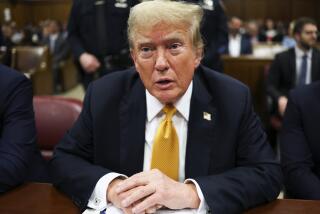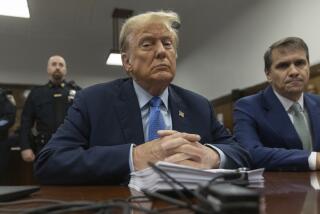Tripp Sold a Scandal That Lost Some Steam Under Oath
- Share via
WASHINGTON — Years from now, once the evidence settles and the memoirs are written, both Bill Clinton and Kenneth W. Starr may have some unflattering words for the woman who made this scandal possible: the relentless Linda Tripp.
In Clinton’s version of history, Tripp may appear as the baleful spirit whose actions knocked his presidency off course and sent him careening toward possible impeachment.
For independent counsel Starr, Tripp is likely to emerge a more complex figure: the key witness who, appalled by Clinton’s behavior, set out to snare the president by secretly taping a young friend--but ultimately left her own credibility in serious doubt.
The massive Starr documents released Friday, intended as evidence against President Clinton, portray his chief accuser, Tripp, as devious and manipulative. They also show, however, why Starr launched a full-scale investigation that in the end yielded less than the counsel may have anticipated.
When Tripp first approached Starr’s staff on Jan. 12, she offered an alarming, incriminating picture of a conspiracy to obstruct justice, describing a President Clinton who allegedly told Monica S. Lewinsky to “deny, deny, deny,” and a Vernon E. Jordan Jr. who purportedly counseled Lewinsky to lie under oath.
Tripp’s account led Starr’s office to open a whole new inquiry into “subornation of perjury and obstruction of justice” related to Lewinsky’s testimony in the Paula Corbin Jones sexual harassment lawsuit against Clinton. At the time, Starr’s team did not even mention simple perjury, which has become the prime focus of the case against Clinton.
Starr still found enough to send allegations of 11 potentially impeachable offenses to Congress, centering on the charge that Clinton lied under oath about his affair with Lewinsky.
But in the transcripts of Tripp’s conversations with Lewinsky released Friday, the evidence of obstructing justice is never quite as crisp as Tripp initially claimed.
In the tape-recordings of their telephone conversations, that arresting quote from Clinton--”deny, deny, deny”--never appears. And Lewinsky never describes Jordan, the president’s friend, as clearly urging her to commit perjury.
Tripp is not the only one at fault. Lewinsky has admitted that some of her most damning statements to Tripp were false--made because she was “panicked” and trying to prevent her friend from revealing her affair with the president.
Lewinsky later admitted that she told Tripp, ‘The president told me I have to lie,’ but that her own statement was untrue.
In sworn testimony before Starr’s grand jury, Lewinsky said that Clinton was never explicit about what she should say. She said she “understood” that she should deny their relationship.
Clinton maintained that he never told Lewinsky to lie.
As for Jordan, Lewinsky told Tripp the lawyer assured her that she could not go to jail for perjury.
“What he has showed me is there’s no way to get caught in perjury in a situation like this,” Lewinsky told Tripp, who was wearing a concealed microphone.
But Lewinsky did not say clearly--even as Tripp pressed her--that Jordan had counseled her to lie.
And later, in her grand jury testimony, the former White House intern said that Jordan never did so.
Instead, she said, some of her statements to Tripp were false--exaggerations told on the spur of the moment.
More to Read
Sign up for Essential California
The most important California stories and recommendations in your inbox every morning.
You may occasionally receive promotional content from the Los Angeles Times.















